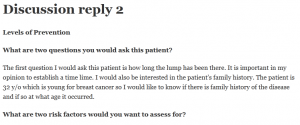Discussion reply 2

Levels of Prevention
What are two questions you would ask this patient?
The first question I would ask this patient is how long the lump has been there. It is important in my opinion to establish a time lime. I would also be interested in the patient’s family history. The patient is 32 y/o which is young for breast cancer so I would like to know if there is family history of the disease and if so at what age it occurred.
What are two risk factors would you want to assess for?
Two risk factors for this patient are family history of breast cancer or other cancers as well as the use of hormonal medications which could be contraception.
What are the levels of prevention for this patient?
Primary prevention includes health promotion and risk reduction. Health reduction includes healthy behaviors that may reduce breast cancer risk which can include physical activity, consuming diets high in fruits and vegetables, smoking cessation, and limiting alcohol. Secondary prevention is the identification and treatment of premalignant or subclinical cancers. Screening by means of mammography is a typical example of secondary prevention. The U.S. Preventive Services Task Force (USPSTF) issued a grade B recommendation for using a risk tool to screen women for BRCA gene mutations if they have a family history of breast, ovarian, tubal, or peritoneal cancers.27 BRCA gene mutations account for up to 10% of all breast cancers (Bickley, 2020, p. 606). A level B recommendation means that The USPSTF recommends the service. There is high certainty that the net benefit is moderate or there is moderate certainty that the net benefit is moderate to substantial. The recommendation for practice is to offer this service. Tertiary prevention is defined as symptoms control and rehabilitation. These definitions may become less useful in the future as they do not account for the new incoming data such as molecular data